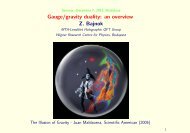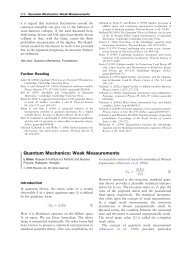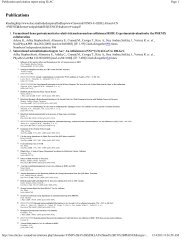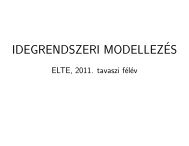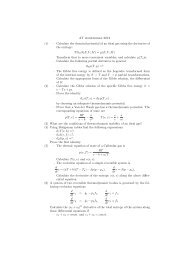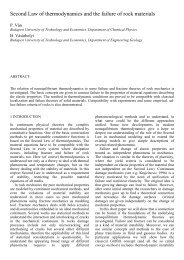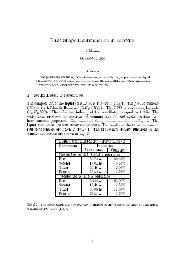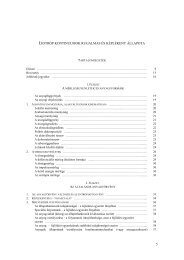hungarian scientists in the us - Columbia University
hungarian scientists in the us - Columbia University
hungarian scientists in the us - Columbia University
You also want an ePaper? Increase the reach of your titles
YUMPU automatically turns print PDFs into web optimized ePapers that Google loves.
Albert-László<br />
Barabási<br />
Education / Academic Career<br />
<strong>University</strong> of Bucharest, major <strong>in</strong><br />
physics and eng<strong>in</strong>eer<strong>in</strong>g, 1986-1989<br />
M.Sc., 1991, Eotvos Lorand <strong>University</strong>,<br />
Budapest, <strong>in</strong> physics;<br />
Ph.D., 1994,<br />
Boston <strong>University</strong>, <strong>in</strong> physics;<br />
Hungary and was awarded a Ph.D.<br />
three years later at Boston <strong>University</strong>.<br />
After a year at <strong>the</strong> IBM T.J. Watson Research<br />
Center, he jo<strong>in</strong>ed Notre Dame<br />
as an Assistant Professor, and <strong>in</strong> 2001<br />
was promoted to <strong>the</strong> Professor and<br />
<strong>the</strong> Emil T. Hofman Chair. Barabási<br />
recently released on April 29th his<br />
newest book “Bursts: The Hidden Pattern<br />
Beh<strong>in</strong>d Everyth<strong>in</strong>g We Do” (Dutton,<br />
2010) available <strong>in</strong> five languages.<br />
He has also authored “L<strong>in</strong>ked: The<br />
New Science of Networks” (Perse<strong>us</strong>,<br />
2002), currently available <strong>in</strong> eleven<br />
languages, is co-author of “Fractal<br />
Concepts <strong>in</strong> Surface Growth” (Cambridge,<br />
1995), and <strong>the</strong> co-editor of<br />
“The Structure and Dynamics of<br />
Networks” (Pr<strong>in</strong>ceton, 2005). His<br />
work lead to <strong>the</strong> discovery of scalefree<br />
networks <strong>in</strong> 1999, and proposed<br />
<strong>the</strong> Barabasi-Albert model to expla<strong>in</strong><br />
<strong>the</strong>ir widespread emergence <strong>in</strong> natural,<br />
technological and social systems,<br />
from <strong>the</strong> cellular telephone to <strong>the</strong><br />
WWW or onl<strong>in</strong>e communities. His<br />
work on complex networks have been<br />
widely featured <strong>in</strong> <strong>the</strong> media, <strong>in</strong>clud<strong>in</strong>g<br />
<strong>the</strong> cover of Nature, Science News<br />
and many o<strong>the</strong>r journals, and written<br />
about <strong>in</strong> Science, Science News, New<br />
York Times, USA Today, Wash<strong>in</strong>gton<br />
Post, American Scientist, Discover,<br />
B<strong>us</strong><strong>in</strong>ess Week, Die Zeit, El Pais, Le<br />
Monde, London’s Daily Telegraph,<br />
National Geographic, The Chronicle<br />
of Higher Education, New Scientist,<br />
and La Republica, among o<strong>the</strong>rs. He<br />
has been <strong>in</strong>terviewed by BBC Radio,<br />
National Public Radio, CBS and ABC<br />
News, CNN, NBC, and many o<strong>the</strong>r<br />
media outlets.<br />
John von Neumann Computer Society<br />
from Hungary, for outstand<strong>in</strong>g<br />
achievements <strong>in</strong> computer-related science<br />
and technology. In 2004 he was<br />
elected <strong>in</strong>to <strong>the</strong> Hungarian Academy<br />
of Sciences and <strong>in</strong> 2007 <strong>in</strong>to <strong>the</strong> Academia<br />
Europaea. Then <strong>in</strong> 2008 he was<br />
an award recipient for <strong>the</strong> C&C Prize<br />
from <strong>the</strong> NEC C&C Foundation. Recently<br />
<strong>in</strong> 2009 APS voted him Outstand<strong>in</strong>g<br />
Referee and <strong>the</strong> National Academies<br />
of Sciences award him <strong>the</strong> 2009 Cozzarelli<br />
Prize <strong>in</strong> Wash<strong>in</strong>gton, DC.<br />
Selected Publications<br />
A.-L. Barabási and H. E. Stanley,<br />
Fractal Concepts <strong>in</strong> Surface Growth<br />
(Cambridge <strong>University</strong> Press, Cambridge,<br />
1995).<br />
A.-L. Barabási, M. Krishnamurthy, F.<br />
Liu, and T. Pearsall (eds.), Epitaxial<br />
Growth – Pr<strong>in</strong>ciples and Applications<br />
(Materials Research Society, Vol. 570,<br />
Werrendale, PA, 1999).<br />
J. Mirecki Millunchick, A.-L. Barabási,<br />
N. A. Mod<strong>in</strong>e, and E. D. Jones (eds.),<br />
Morphological and Com-positional<br />
Evolution of Heteroepitaxial Semiconductor<br />
Th<strong>in</strong> Films (Materials Research<br />
Society, Vol. 618, Werrendale,<br />
PA, 2000).<br />
A.-L. Barabási, L<strong>in</strong>ked: The New Science<br />
of Networks (Perse<strong>us</strong>, Cambridge,<br />
MA, 2002) [available <strong>in</strong><br />
Check, Croatian, Ch<strong>in</strong>ese, F<strong>in</strong>nish,<br />
Hebrew, Hungarian, Italian, Japanese,<br />
Korean, Turkish].<br />
M. Newman, D. Watts and A.-L.<br />
Barabási, The Structure and Dynamics<br />
of Networks (Pr<strong>in</strong>ceton <strong>University</strong><br />
Press, 2006).<br />
Biography / Interests<br />
Albert-László Barabási is a Dist<strong>in</strong>guished<br />
<strong>University</strong> Professor at<br />
Nor<strong>the</strong>astern <strong>University</strong>, where he<br />
directs <strong>the</strong> Center for Complex Network<br />
Research, and holds appo<strong>in</strong>tments<br />
<strong>in</strong> <strong>the</strong> Departments of Physics,<br />
Computer Science and Biology, as<br />
well as <strong>in</strong> <strong>the</strong> Department of Medic<strong>in</strong>e,<br />
Harvard Medical School and<br />
Brigham and Women Hospital, and<br />
is a member of <strong>the</strong> Center for Cancer Awards<br />
Systems Biology at Dana Farber Cancer<br />
Institute. A Hungarian born native can Physical Society. In 2005 he was<br />
Barabási is a Fellow of <strong>the</strong> Ameri-<br />
of Transylvania, Romania, he received awarded <strong>the</strong> FEBS Anniversary Prize<br />
his Masters <strong>in</strong> Theoretical Physics at for Systems Biology and <strong>in</strong> 2006 <strong>the</strong><br />
<strong>the</strong> Eötvös <strong>University</strong> <strong>in</strong> Budapest, John von Neumann Medal by <strong>the</strong><br />
3622122 21 22<br />
Human Dynamics: Can We Predict<br />
Human Behavior?<br />
Albert-László Barabási Center of<br />
Complex Networks Research,<br />
Nor<strong>the</strong>astern <strong>University</strong> and<br />
Department of Medic<strong>in</strong>e, Harvard<br />
<strong>University</strong>.<br />
A fundamental goal of science is to<br />
produce tools and methods with predictive<br />
power. While are comfortable<br />
with predict<strong>in</strong>g <strong>the</strong> trajectory of a<br />
planet or <strong>the</strong> behavior of a gene, predict<strong>in</strong>g<br />
human behavior is often a<br />
seen as more science fiction than science.<br />
Indeed, can human activity patterns<br />
be predicted? This question is<br />
not only of academic <strong>in</strong>terest: a range<br />
of applications, from <strong>the</strong> spread of<br />
human and electronic vir<strong>us</strong>es to city<br />
plann<strong>in</strong>g, depend on our ability to understand<br />
and predict human activity<br />
patterns. Us<strong>in</strong>g human mobility as a<br />
proxy of human dynamics, I will ask<br />
<strong>the</strong> simple yet loaded question: can we<br />
predict where will you be tomorrow?<br />
The answer is yes, rais<strong>in</strong>g fundamental<br />
questions at <strong>the</strong> boundary of human<br />
behavior, predictability and free will.



